Van Nievelt Company, Goudriaan & Co’s
Steamship Company / Rotterdam Zuid Amerika Lijn - Their "A Ships"
Passenger-Cargo Liners
Use Google Chrome for this web page to load perfectly!
Click the logo above to reach the ssMaritime FrontPage for Ships of the Month & News Updates
With
Maritime Historian, Cruise‘n’Ship Reviewer, Author & Lecturer
Please Note: All ssmaritime as well as my other related maritime & cruise sites are 100% non-commercial and privately owned sites. Be assured that I am NOT associated with any shipping or cruise companies or agencies or any other organisations! The author has been in the passenger shipping industry since May 1960, but although retired and unwell, I occasionally attempt to write an article now and then, in order to bring enjoyment and pleasure to ship enthusiasts past passengers and crew.
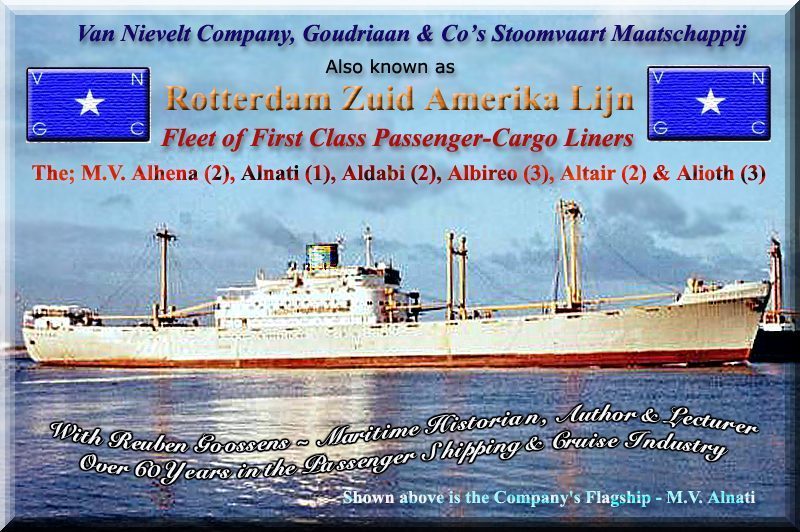
Photographs
are from the ssMaritime historic collection - unless stated otherwise
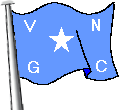
The
“Van Nievelt Company, Goudriaan & Co’s
Page One
Part One:
Introduction to
“NiGoCo”:
Ten years later, in 1920, in cooperation with “Holland America Line” (‘HAL’), they commenced a direct freight a regular cargo service from Hamburg, sailing via Rotterdam and Antwerp the sailing direct to Argentina, although it was wholly owned by “van Nievelt, Goudriaan & Co”, the company in the Netherlands became better known as the “Rotterdam-Zuid Amerika Lijn” or ‘RZAL’, or the rest of the world as the “Rotterdam South American Line”.
Part Two:
Early Ships with Passenger Accommodations & WW2 Losses:
S.S. Alcyone & Aldabi:
In 1921 there was a new stage for the Company,
as they introduced several new ships that a capacity for 12 passengers, and the
first these were the 4,540 DWT - S.S. Alcyone of and the 4,938 DWT -
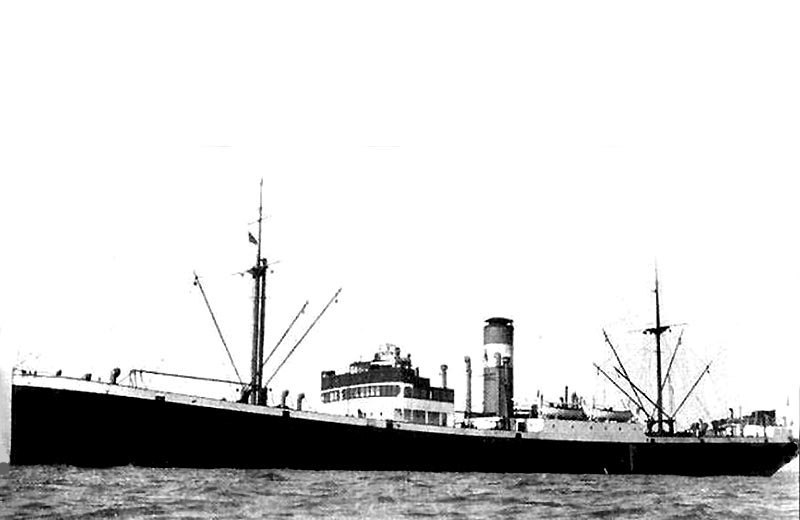
The
S.S. Alcyone of 1921 she was the first of the ‘RZAL’ ships to carry
passengers
Then twin sister ships the
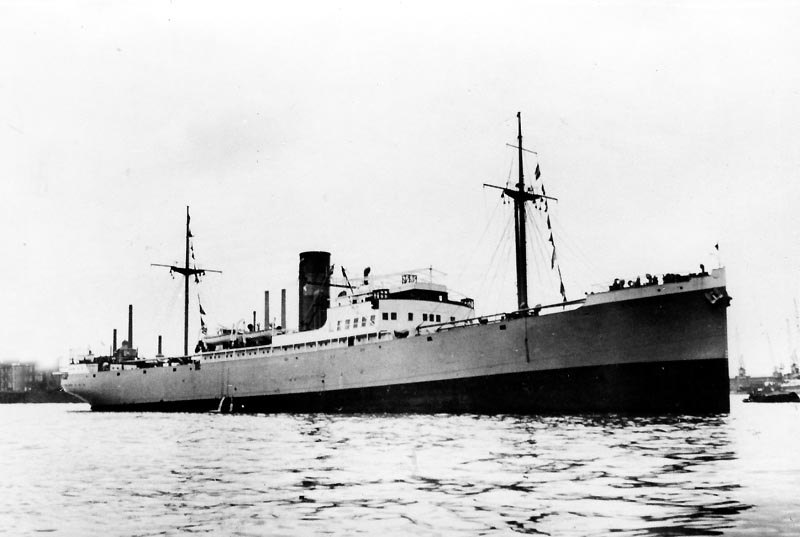
A
photograph of the 1928
The
Sadly during WW2 whilst en route from Cape
Town to Freetown, under the command of Captain R. J. van de Laan,
and the ship being located 150 miles south of Cape Palmas (West Africa) she was
Torpedoed and sunk by the German U-Boat “U-505” at position 01.50°
N, 07.40 ° W, and sadly 15 members of the crew were killed. The
“U-505” was under the command of
The S.S. Alpherat (1) like her sister was also built by “Wm Gray & Co Ltd”, West Hartlepool, ans she also had accommodation for 12 passengers, again in 1938 she was rebuilt and when completed she accommodated 24 passengers.
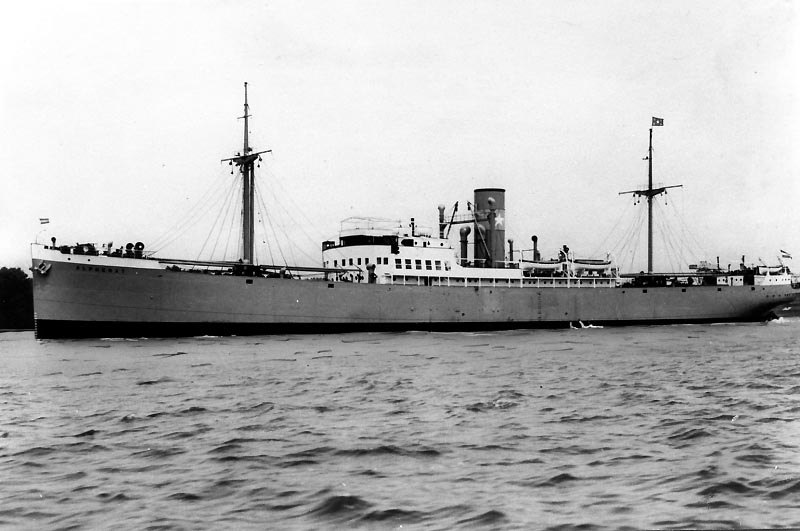
The
The
Then, at 4.55 pm the Alpherat was hit by a bomb near and slightly forward of the starboard bridge, and an explosion happened in hold 2 with water entering the hold at a high volume. The watertight doors were rapidly closed, but it seemed that water was also pouring into hold 1.
It was decided that all 23 passengers on board had to prepare to leave the ship. Although pumping out the water in holds 1 and 2 it continued to rise, but thankfully for the time being the ship managed to hold position in the convoy.
Then at 5.25 pm it became abundantly clear the
ship could not be kept afloat much longer and Captain reduced the speed until;
the ship came to a halt. Then her 23 passengers and all her crew of 65 left the
ship and waited at a save distance until they were picked up by one of the
escort vessels, but they remained near the sinking ship for they were well
aware that the ship could brake in two and sink, which she did at 7.10 pm. The
Alpherat sank 150 miles east of
M.S. Altair 1:
The 7,258 DWT - M.S. Altair (1) was laid down
before the
Many of the earlier ‘NiGoCo’ steam ships were commissioned for war duties and tragically eleven of their ships were lost, and we have learned about some of these above. In Part Three, we learn of other ships in building that were taken over by the Germans, but were returned to ‘NiGoCo’ after the war.
Part Three:
The Three Luxury and
Glamour ships of the fleet - M.V. Alhena
The Alhena (2) was built by “Netherlands
Ship Building Co”,
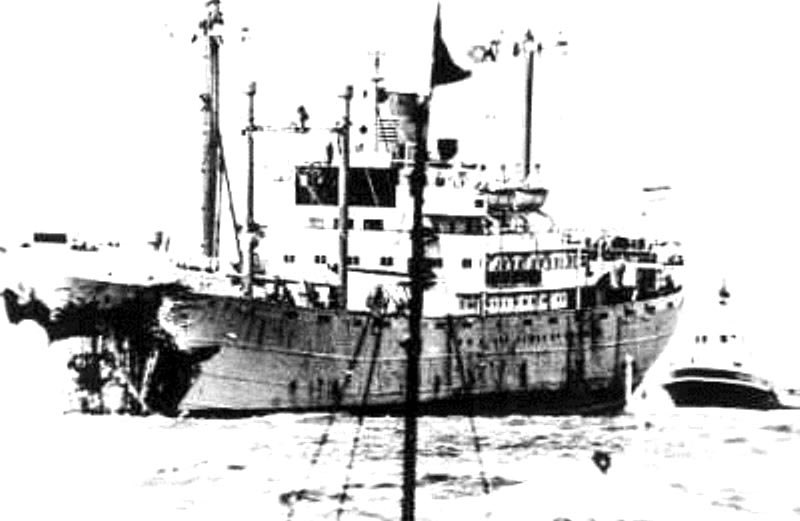
A sad view of the Alhena’s severe damage
Thankfully, in 1947 she was raised and taken to the ship yard where she was fully repaired and given a full refit making her suitable to be returned to ‘NiGoCo’ who then renamed her the “Alhena” (2).
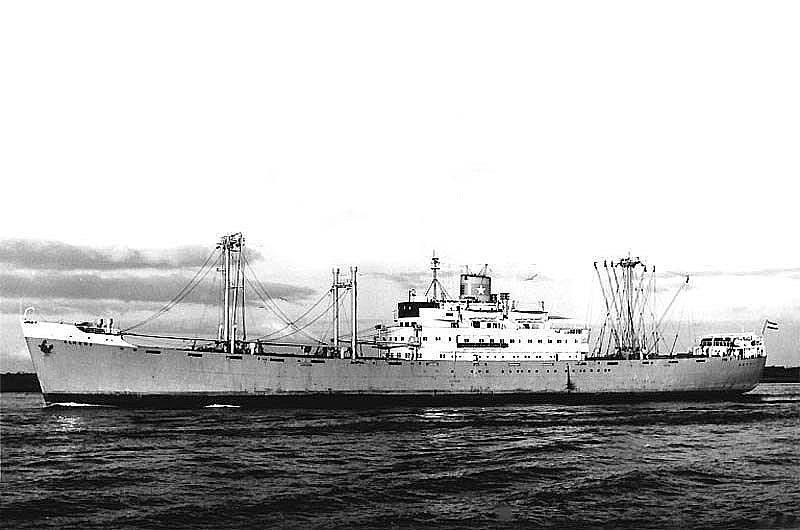
She was 7,289 GRT - 9,480 DWT, had a length of
477 ft, a width of 60 ft and a draught of 25.9 ft, and accommodated 45 First
Class passengers on three guest decks.
The Alnati (I) was built by
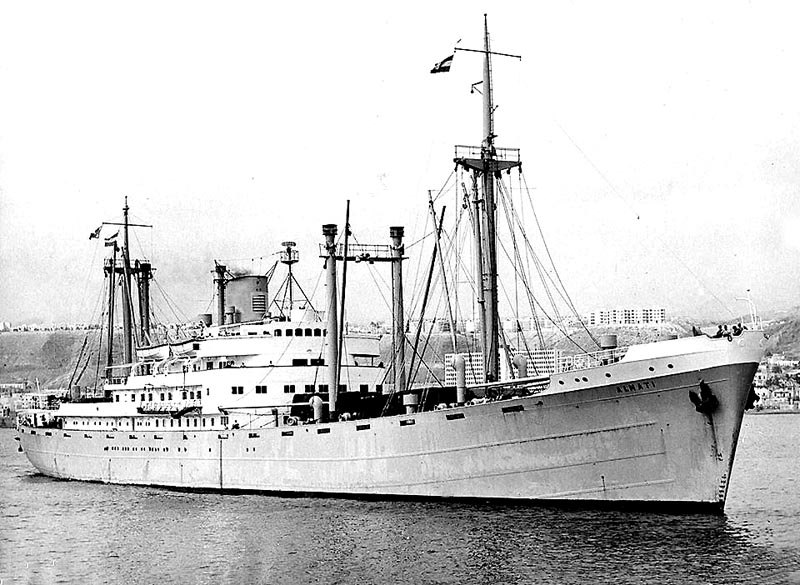
An
excellent photograph of the
Provided by
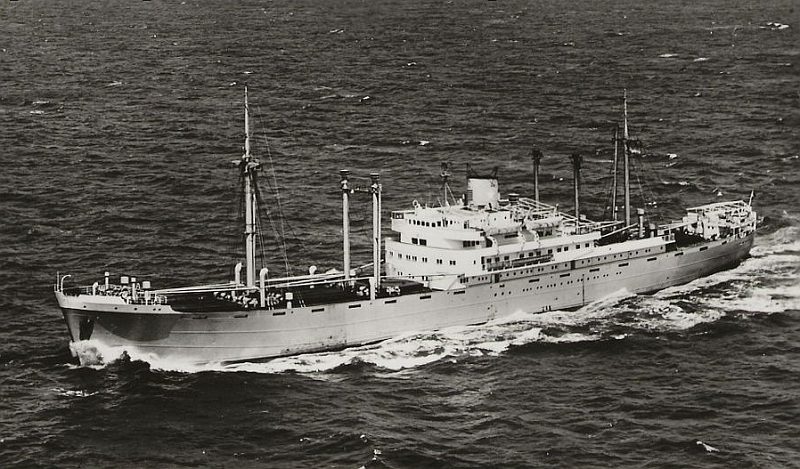
A
fine aerial view of the “Alnati”
The Aldabi (2) was built by “Netherlands
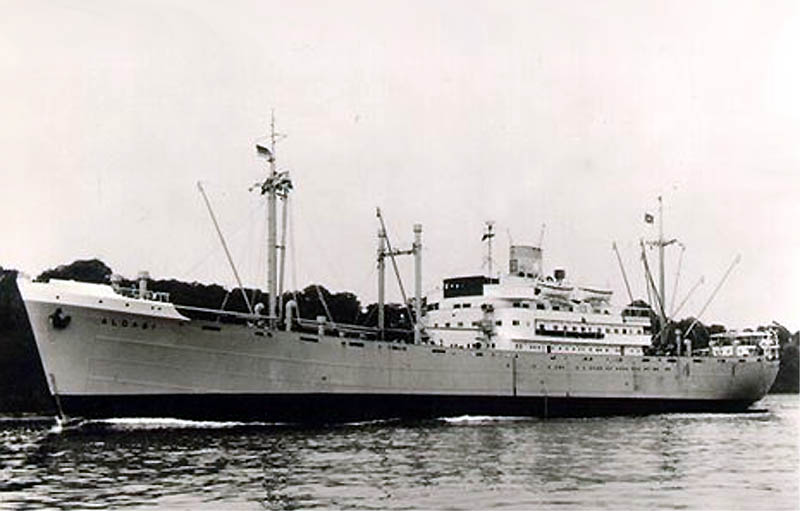
The source of this photograph is unknown; please see my photo notes at the bottom of the page
She was 7,239 GRT - 9,480 DWT, had a length of 477 ft, a width of 60 ft and a draught of 25.9 ft, and accommodated 45 First Class passengers on three guest decks.
***********************************
Please Note:
In Part Four I will describe the above three ships interiors and decks, etc, together with photographs, etc, whilst Part Five will cover their final days. Part Six has their Specifications and General Details and Part Seven has three other ships, the Albireo (3), Altair (2) & Alioth (3) and finally in Part Eight the last three ships to carry passengers, but featuring the very last one ever to be built, the excellent 12 passenger M.V. “Algorab”.
Then on Page Two you will find the
three main ships Deck Plans as well as those of the; M.V.
***********************************
Part Four:
Promenade Deck:
Far forward was a spacious beautifully designed Lounge being the heart of the ship for her passengers, directly aft on both sides were two Spacious Halls, leading to the grand Stairwell going down to Cabin and Shelter Decks. On the Starboard side was a cosy timbered Library with comfortable furnishings and two writing tables. Whilst along the portside was the location of the long Bar, which overlooked the Lounge and there was a door that led out to the ever popular Verandah out on the aft deck. Of course this was the very spacious walk-around Promenade Deck. But the Verandah was fully covered and glazed I and well furnished, thus a well used location for morning coffee and a snack or afternoon tea, etc as well as a drink from the bar, served by a friendly Dutch bar man.
Cabin Deck:
The Alhena and Aldabi layouts were almost identical, as each of these ships had 23 cabins, accommodating 45 passengers all being located on Cabin Deck. The two spacious luxury Twin/Double Luxury Staterooms located forward, one on the starboard, and the other the Portside had their own private facilities, whilst all other cabins had one bathroom located between two cabins and they shared this bathroom, which had a toilet and a shower, two basins were in each cabin. When a guest entered the bath room they would lock the door of the other cabin, etc. This system worked well. In addition there were other spotless facilities close by for both males and females. Cabin Deck on all three ships also had the Dispensary and Hospital located inside far aft, overlooking the aft decks, whilst the Alnati also had a Hairdressing Salon just forward of the Medical Centre.
Shelter Deck:
The Main venue on this deck was located far
forward, being the glamorous Dining Saloon, where the cuisine and the service
were well known to be simply out standing. There was nothing else on this deck
for the
However as the Alnati accommodated 54
passengers, she had 4 additional cabins along the starboard side of Shelter
Deck, offering single, twin or a Pullman berth for a third passenger. And on
this, the flagship of the fleet, every cabin had private facilities. In
addition the
On all ships Gifts and other items could be obtained from the ships Bar, which was also the ships a small shop. At certain times an Administration Officer would be able to assist with passenger needs on board the Alhena and Aldabi as they did not have a dedicated Pursers office, like on the Alnati.
Now, go and enjoy the Photo Album below.

M.V/
Alhena (2)
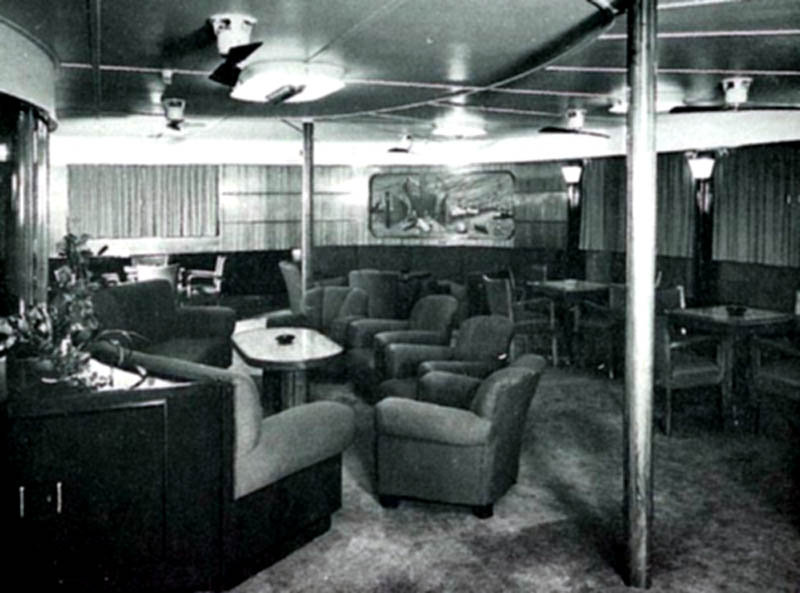
The
elegant forward Lounge
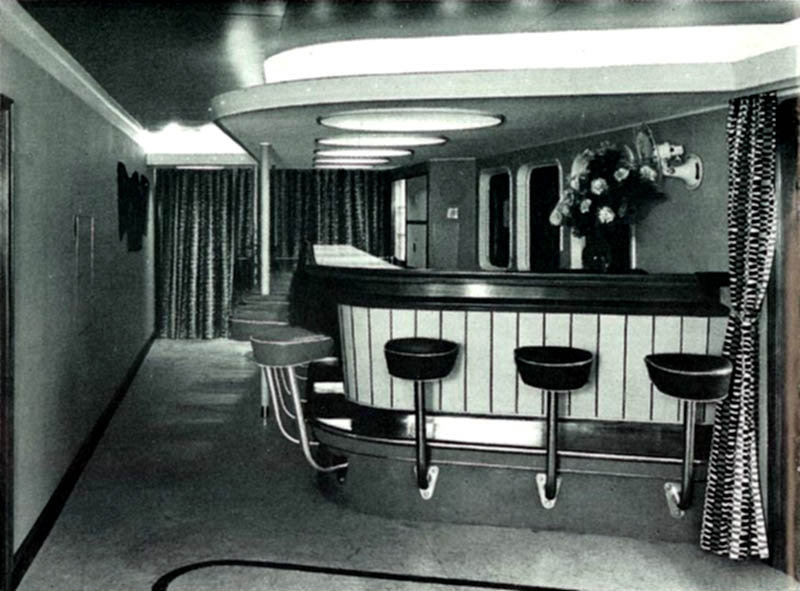
The
Bar
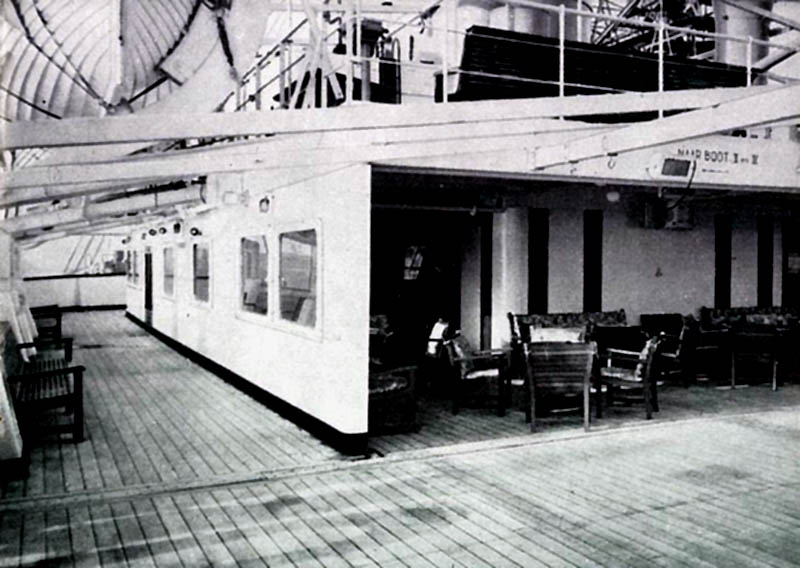
The
delightful aft sheltered Verandah
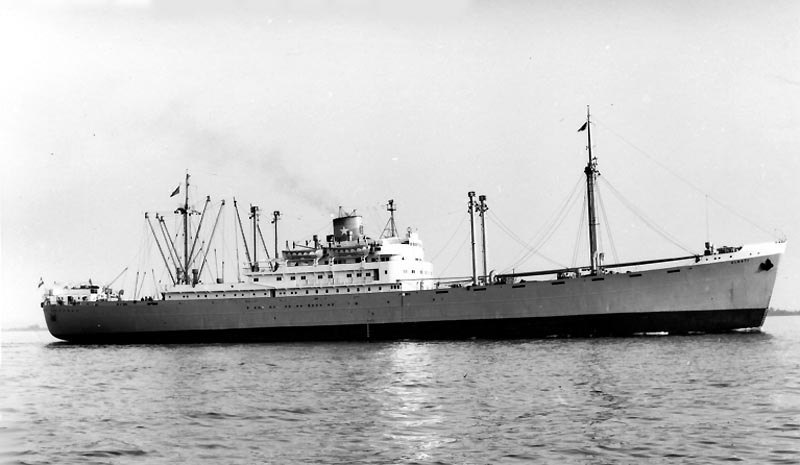
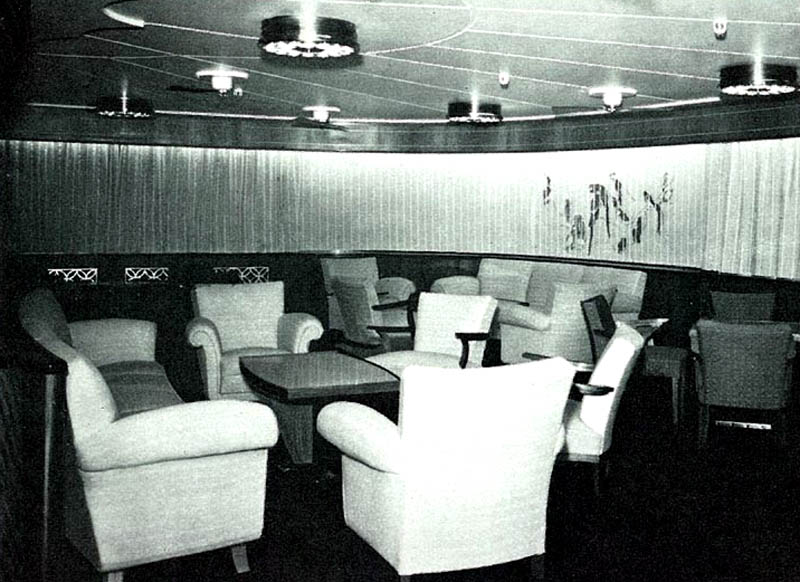
The
Lounge
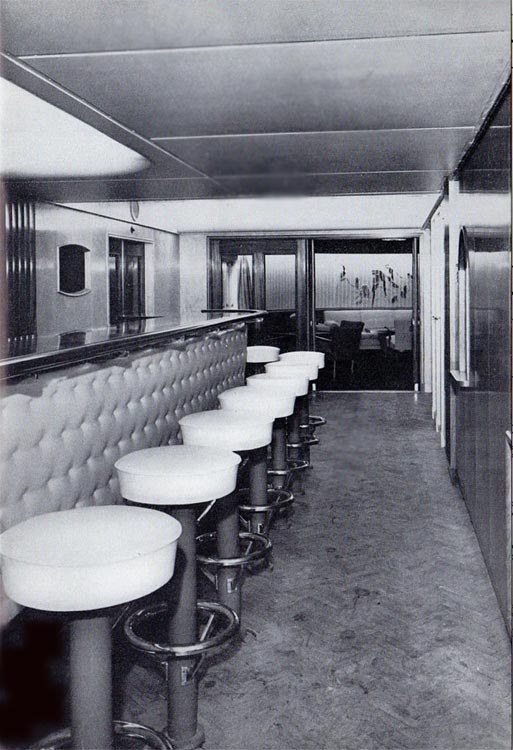
The
Bar, looking forward towards the Lounge
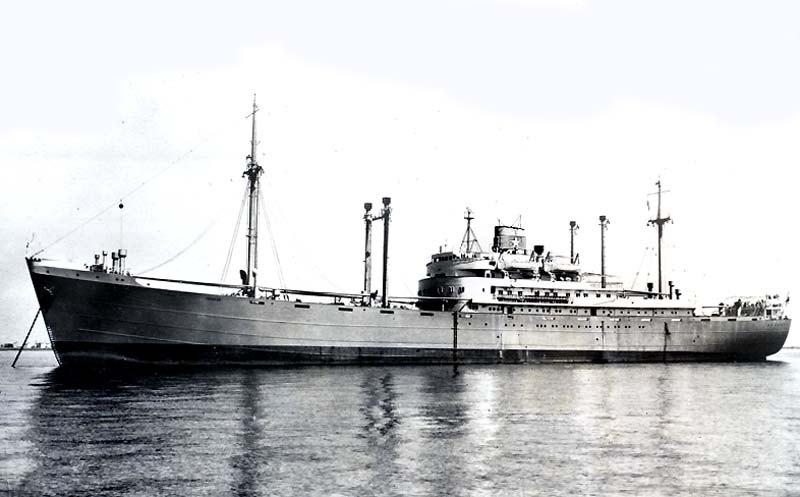
The Alnati at anchor
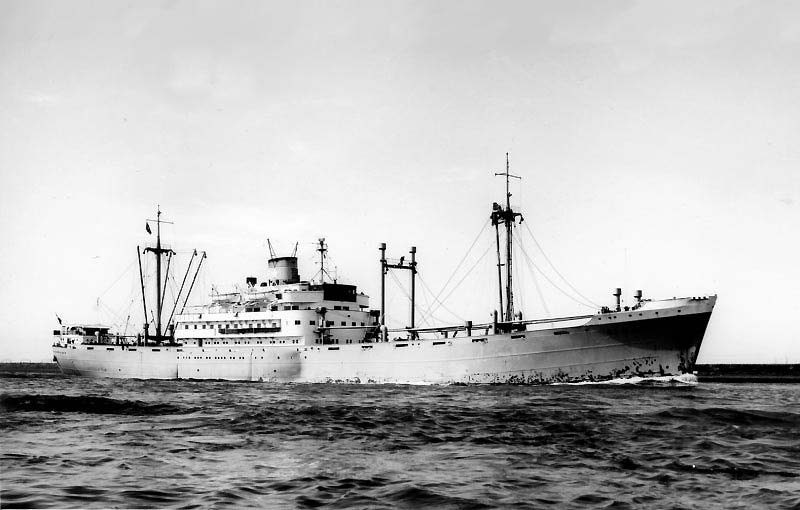
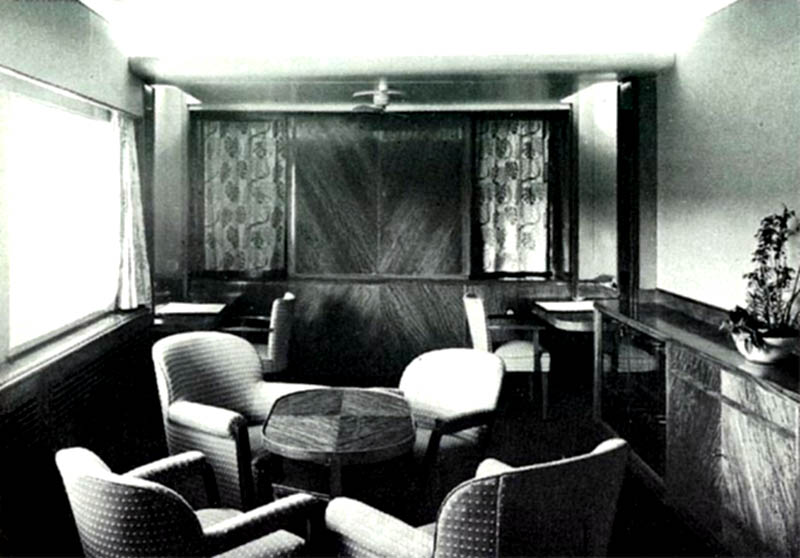
The
Reading Room
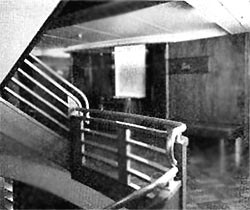
The
Stairwell
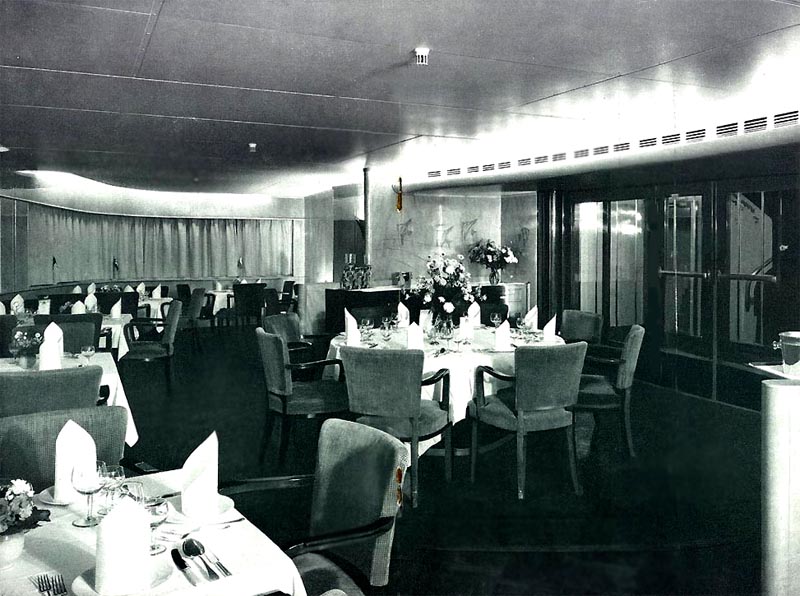
The
elegant Dining Room
Schedules:
From:
Return Voyage:
C - Service:
From: Bremen, Hamburg, Rotterdam and Antwerp to Recife (Brazil), Salvador, Rio de Janeiro, Santos, Sao Fancisco do Sul, (Brazil), Rio Grande (Brazil) and Porto Alegre (Brazil).
Return Voyage:
Porto Alegre, Rio Grande, Sao Fancisco do Sul, Santos, Rio de Janeiro, Vitoria (Brazil), Salvador and
Recife to Antwerp, Rotterdam, Hamburg and Bremen.
Part Five:
The final Days M.V. Alhena
(2), Alnati (1), Aldabi (2):
The same applied to the ‘Alnati’, which was also
disposed in 1968, as she was sold to
Although in 1967 the ‘Aldabi’ had
also been sold to a
Ships - 1.
Delivery
Date: 1. 1943, 2 & 3. 1942.
Category: Passenger-Cargo
Ships.
Propulsion: Motor Vessel.
Deck Type: Open Shelter Deck.
Material
Passenger Decks: 5.
Construction Data:
Ships - 1.
Builder: 1.
. 2. & 3.
Yard N°: 1. 279, 2.
81, 3. 82.
Laid Down: 1.
June 28, 1940, (named Agol (1).
. 2.
September 2, 1939.
. 3.
1940.
Launched 1. June 28, 1940, 2.
May 31, 1940, 3. November 23, 1940.
Delivered: 1.
1943, 2. January 20, 1942, 3. February 2, 1942.
Technical Data & Conclusion:
Ships - 1.
Engine
Manufacturer:
Engine: Motor, Oil,
2-stroke single-acting.
Cylinders: 8.
Power: 4,400 BHP.
Speed: 13 Knots.
Propellers: Single Screw.
Tonnage: 1. 7,289 GRT.
2. 7,368 GRT. 3. 7,239 GRT.
Length: 1. & 3.
450.60 ft, 2. 476.83 ft.
Beam: 60.20 ft.
Depth: 27.00 Ft.
Accommodations: 1. & 3. 45, 2. 54 (First Class) passengers.
Holds: 1.
2. & 3. Five holds.
Rigs: 16 winches, 18
derricks.
Lift
Capacity: 1x40,
1x30, 10x7 & 6x3 tons each.
Grain: 1.
568,000, 2 & 3. 559,000 Cubic Feet.
Bale: 1.
521,000, 2 & 3. 515,000 Cubic Feet.
***********************************
Part Seven:
M.V. Albireo
Amongst these three fine Passenger-Cargo ships there is one vessel that offered 14 passengers, and two vessels with 12 passengers. But each ship has accommodations and facilities were of a very high standard of First Class, as we will see below.
Albireo (3):
This 6,474 GRT ship was built by
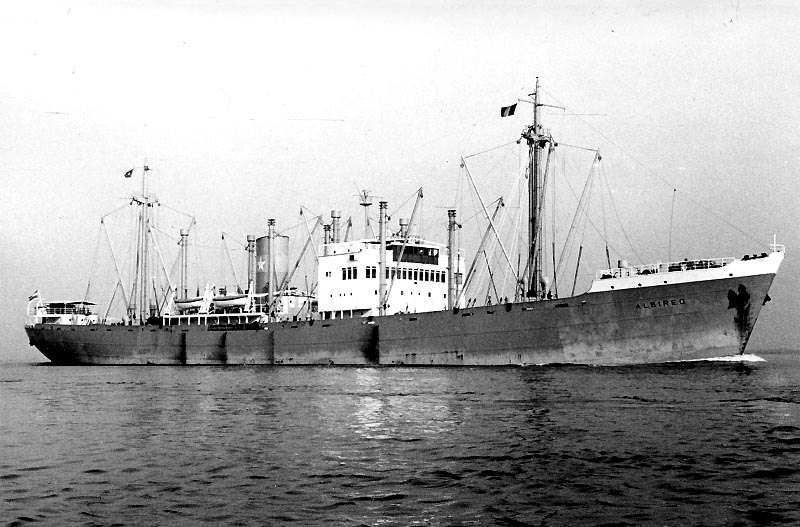
Although not the most elegant of the ‘NiGoCo’ ships, but her passenger facilities were superb!
The
On April 25, 1963 she was transferred to ‘NiGoCo Hamburg’, and she was renamed ‘Procyon’, but then on December 20, 1966 she was sold to “Minoutsi Shipping Ltd” of Monrovia, who renamed her “Minoutsi”.
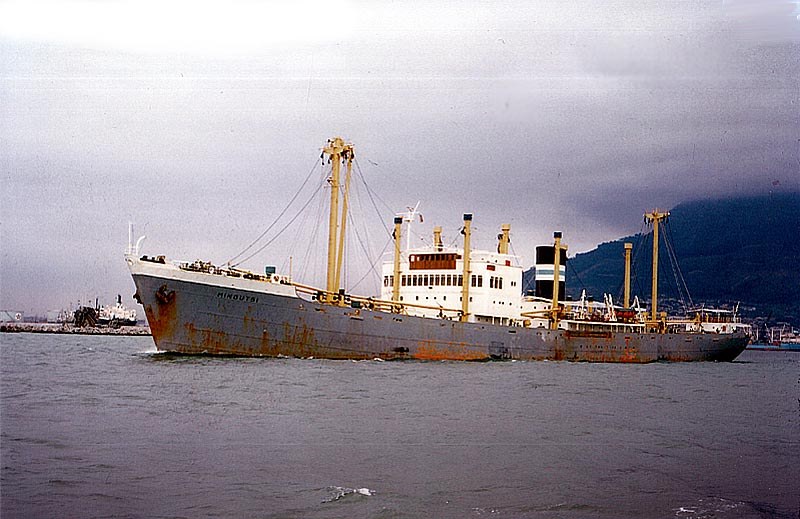
Here
see the Albireo as the
In 1971 she was chartered to a Cypriot
company, but was not renamed. in 1977 she was laid up, in September 1978 the Minoutsi was sold to “Lasia
Maritime Ltd”, Limassol, Cyprus and was renamed “Lasia”. However, she was sold to be broken up early
in 1980 to “Keun Hwa
Iron Steel Works & Enterprise Ltd” of
M.V. Altair (2):
This 6,410 GRT ship was built by Wm. Gray
& Co Ltd,
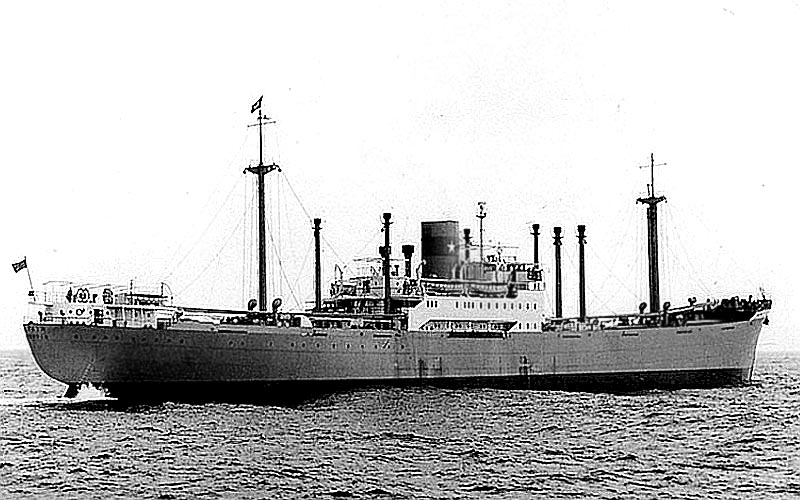
M.V. Altair seen sailing at full speed ahead at sea
She accommodated 12 First Class Passengers, all being located on a single deck, with cabins being either a single, twin cabin or double bedded staterooms, with all having private facilities. Aft on this same deck was the Lounge on the starboard side, with the dinning Room on the portside, with the Bar directly aft, and outside was the spacious Verandah. Above were deck paces on Boat and Bridge decks.
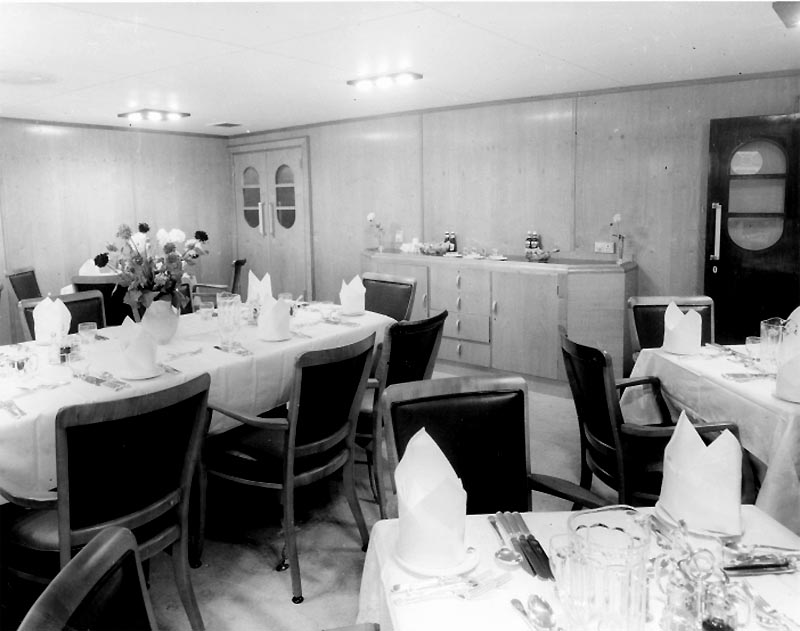
The
Dinning Room, located portside aft
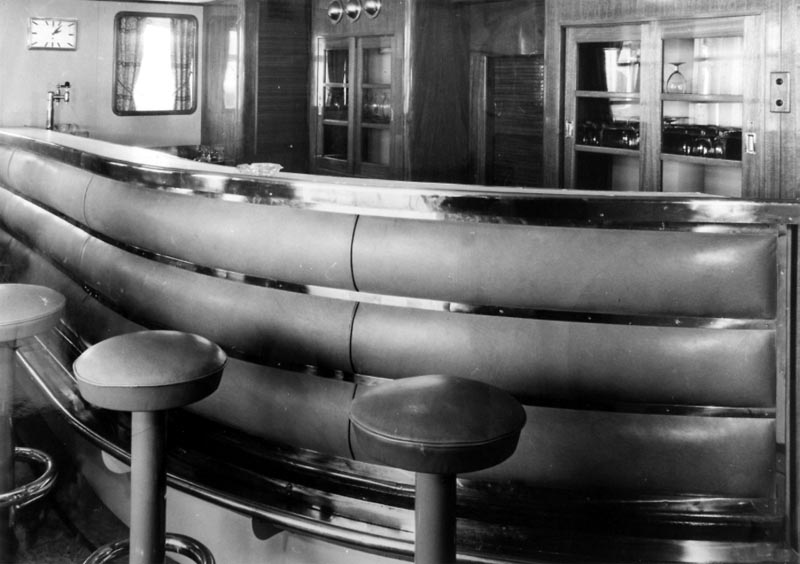
The
Bar located portside aft
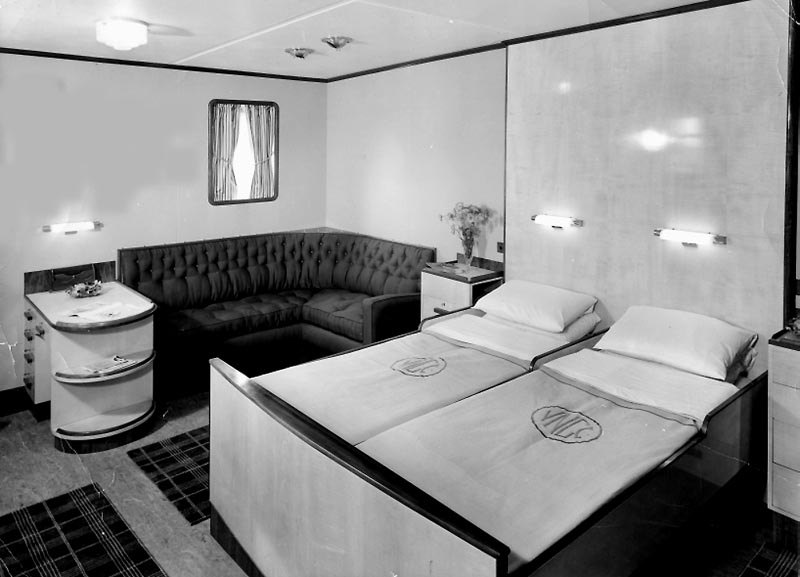
Above & below: This is double bedded Stateroom N°4, located far forward on
the starboard side, it certainly
reveals the high standard of her accommodations
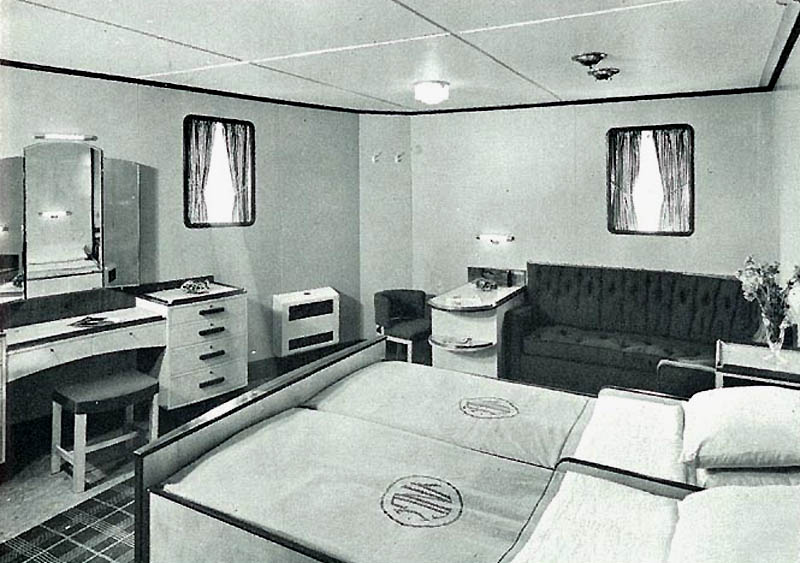
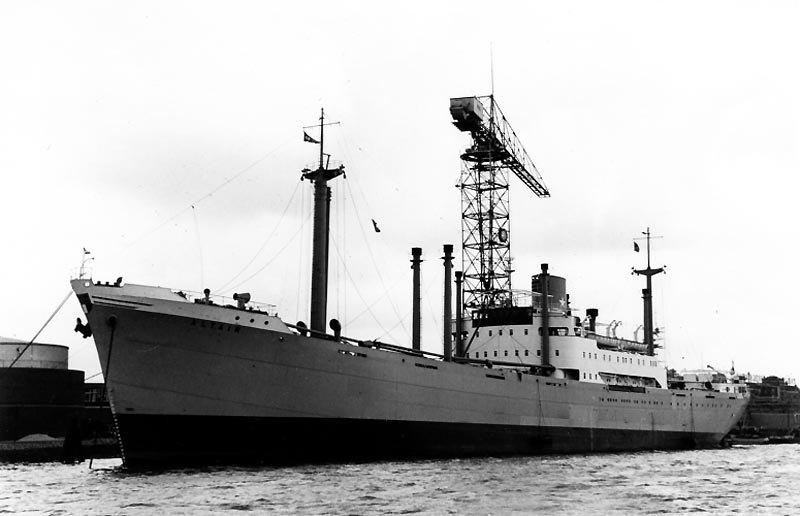
Another
photo of the M.V. Altair berthed
Whilst on her way from
This 5,421 ton ship was built by “Burntisland Shipbuilding Company Ltd”,
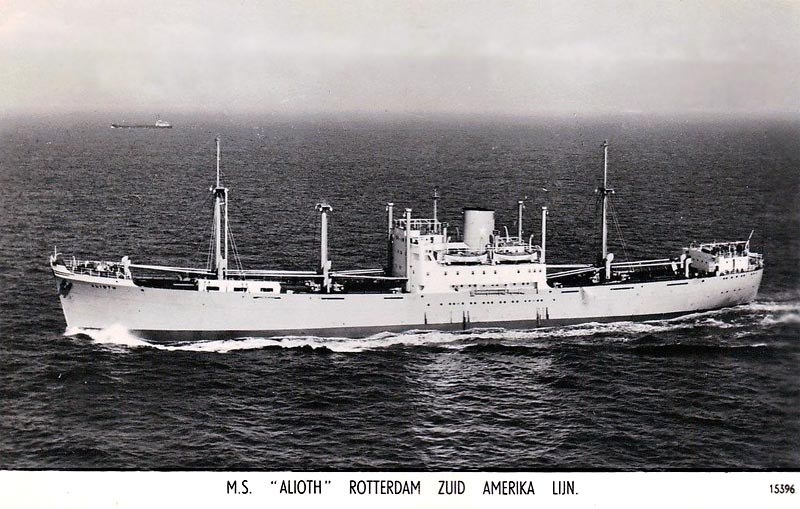
A
postcard of the 12 passenger
On her accommodation and Lounge Deck were six
Single Cabins, one Twin bedded Cabin and two Twin bedded Staterooms. All rooms
were fully equipped and had Private facilities.
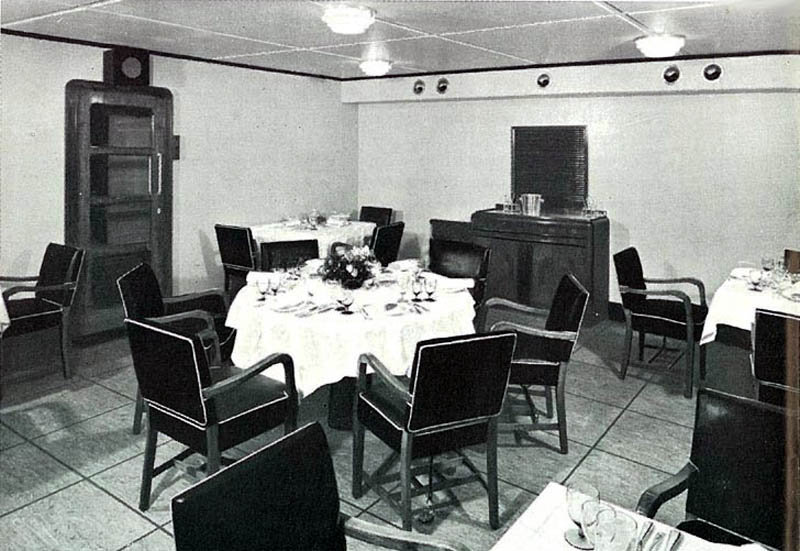
The
Dining Room
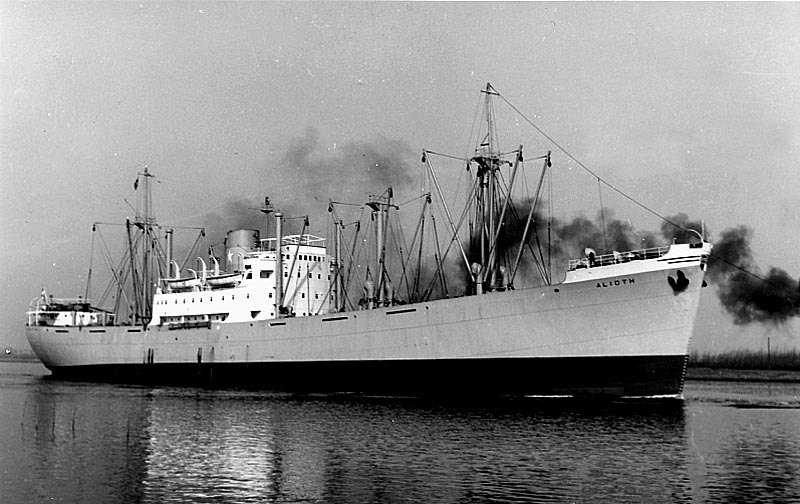
The Alioth is seen riding high as she has just unloaded most of her cargo
The M.V. Alioth sailed on for just over 12
years, but on March 20, 1963 she was transferred to
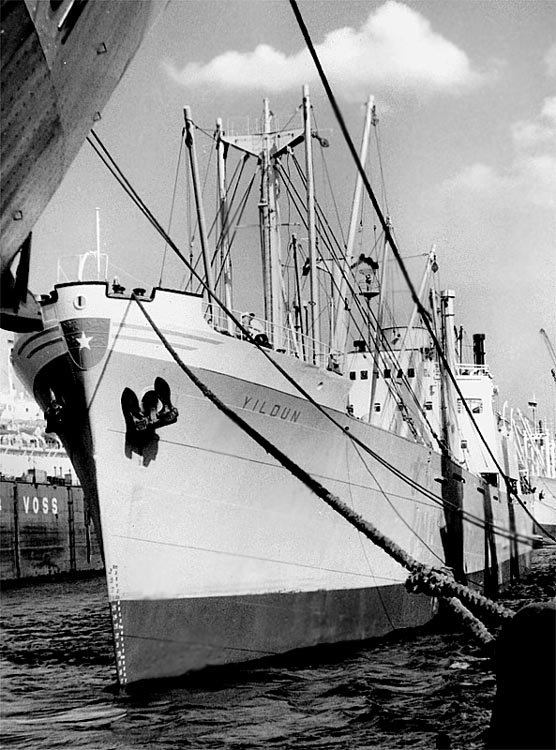
Here
we see the
In 1970 the Yildun was sold to the Greek
“Toxotis Compañiá Naviera SA ,
The
There is nothing known of the ships schedules once she was sold, except her new owners and the flag she sailed under, but she was chartered by a Greek company in 1974 and 1974 and she sailed under the Greek flag during that time, but returning to the Cypriot flag thereafter.
All we know about her final days is that she
sailed to
Part Eight:
The final Passenger-Cargo Ships for ‘RZAL’:
The last of the “Rotterdam South America Line (RZAL) ships to carry twelve passengers, were the M.V. “Alkes”, “Algol” and the delightful M.V. “Algorab”, and they where sold in November and December 1977. This meant that then the RZAL had finally stopped carrying passengers.
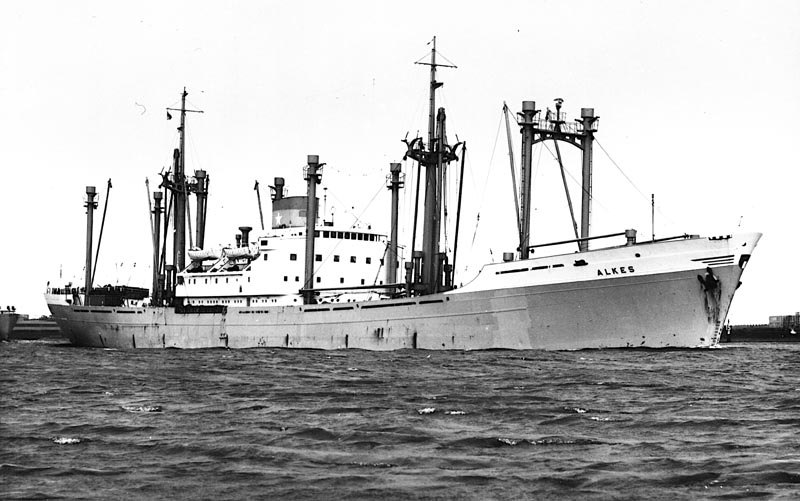
And
here we see the 6,735 GRT M.V. Alkes and she was completed in 1957
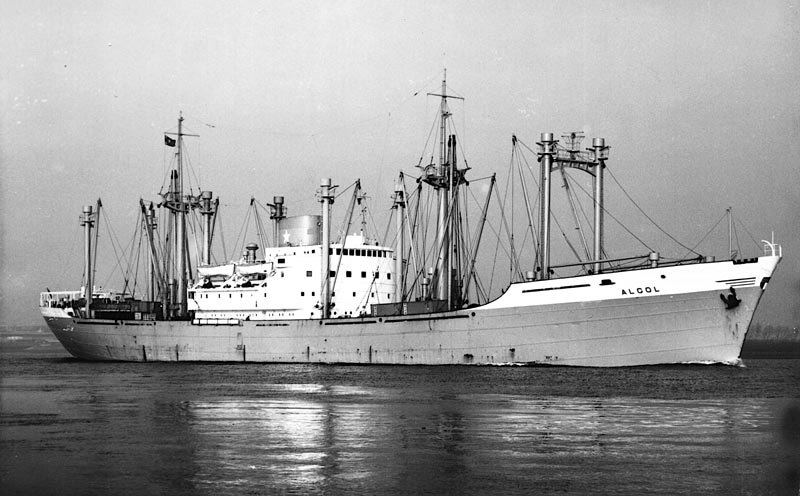
This
is the 6,735 GRT M.V. Algol completed in 1958
This 6,723 GRT ship was laid down in Yard
N°648 named the “Nashira”, and was
constructed by; “
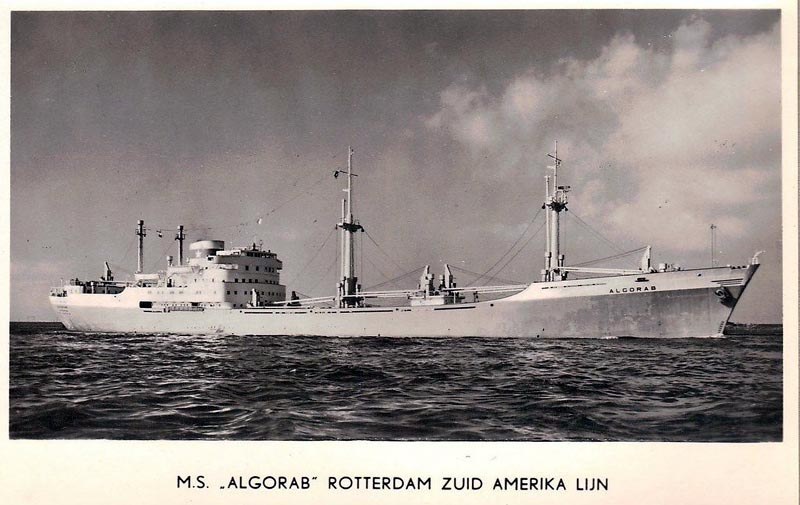
A
RZAL postcard of the
This was without a doubt an attractive looking ship with her engines and superstructure located aft, in addition, she accommodated 12 First Class Passengers in luxury and the ultimate of style.
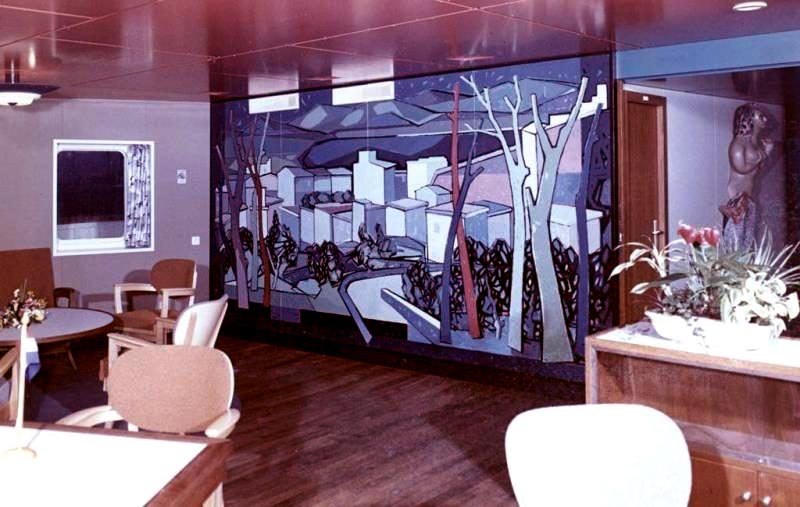
A
modern and colourful Dinning Room on the Algorab
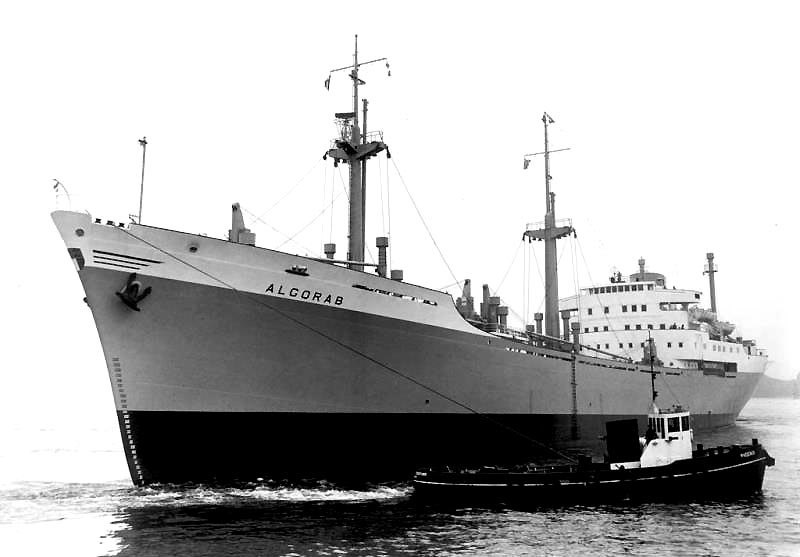
A
wonderful bow view of the stylish and sleek
On November 19, 1977, she was sold to the
“Greek-Holland Shipping Company Ltd”,
Then in 1979 she was sold to “Dionikos Shipping Company Ltd”,
The outbreak of the war between
***********************************
Additional Information on ‘RZAL’ & ‘NiGoCo’:
In the years 1956 to 1960, the rebuilding of
the fleet continued with eight more cargo ships with passenger facilities.
Fruit ships were also operated from 1956. In order to gain a foothold in the
tanker business, ‘NiGoCo’ founded the
The last ships to carry twelve passengers, the “Algol”, “Alkes”, and the delightful “Algorab” were also sold in November and December 1977. This meant that the RZAL had stopped carrying passengers. Between 1956 and 1960, the rebuilding of the “NiGoCo’ fleet continued with the arrival of eight more passenger-cargo ships, as well as some fruit ships that were also operated from 1956.
In order to gain a foothold in the tanker
business, ‘NiGoCo’ founded the
But sadly in 1991 ‘NiGoCo’ finally
became insolvent, and the company was then dissolved and their last three
ships, the “Norrsundet”, the “Skutskar” and the “Aldabi (4)” were sold
in 1993.
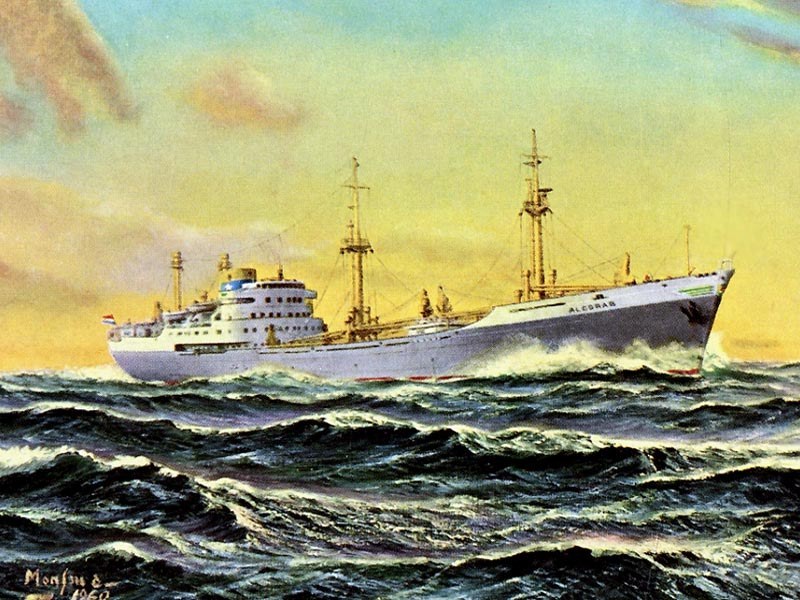
A
magnificent painting of the
of what had been a fine luxury First Class Passenger-Cargo Shipping Company!
After the
As I said earlier, the
But sadly in 1991 the “Van Nievelt and Goudriaan Co” (“Rotterdam Zuid Amerika Lijn”) finally became insolvent and the company was then dissolved and two years later and, their last three identical 4,059 GRT ships being cargo & takers vessels were all sold in 1993;
1. The “Norrsundet” (completed September 1989); 2. The “Skutskar” (completed December 1989); 3. And the last ship of the fleet was the “Aldabi” (4). She was delivered in February 1990 and sold in 1993.
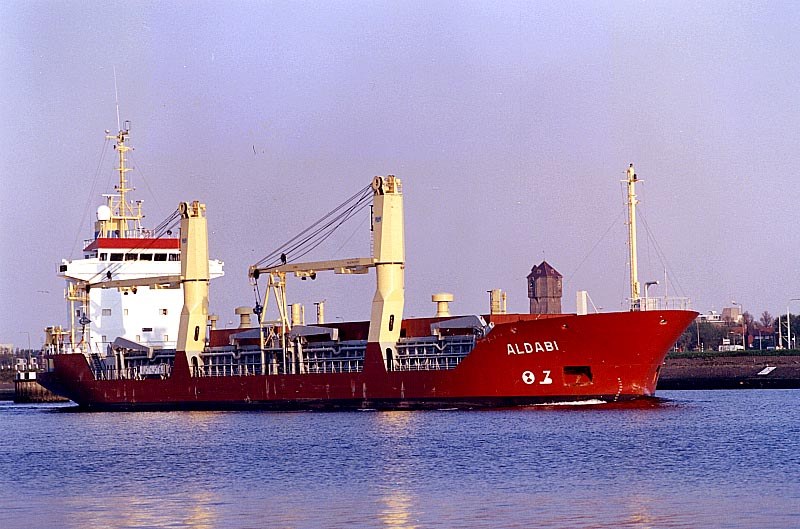
This is the very last ‘NiGoCo’ ship to be built
In Conclusion:

Remembering the Three Glamour Passenger-Cargo Ships of the Fleet

*Photo above is of the
Visit Page Two for Deck Plans and some Memorabilia Items
***********************************
“Blue Water Liners
sailing to the distant shores.
I watched them come, I watched them go and I watched them die.”
Return to the ssMaritime MAIN INDEX
ssMaritime.com & ssMaritime.net
Where you will discover over 1,355 Classic Liners & the 1914 built
Please Note: ssmaritime and associated sites are 100% non-commercial and the author never seeks any funding or favours of any shape or form, never have and never will!
Photographs on ssmaritime and associate pages are: by the author or from the author’s private collection. In addition there are some images that have been provided by Shipping Companies and private photographers or collectors. Credit is given to all contributors. However, there are some photographs provided to me without details regarding the photographer/owner concerned. I hereby invite if owners of these images would be so kind to make them-selves known to me (my email address may be found on www.ssmaritime.com only), in order that due credit may be given.
This notice covers all pages: although, and I have done my best to ensure that all photographs are duly credited and that this notice is displaced on each page, that is, when a page is updated!
ssMaritime is owned & © Copyright
by
